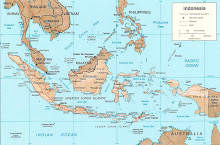 Borobudur, in the vicinity of the village of Magelang, about 40 km Northwest of Yogyakarta, is one of the Wonders of the World. It is the largest Buddhist temple and it was built by one of the kings of the Dynasty Cailendra, somewhere between the end of the Eighth Century and the beginning of the Ninth. In 950, one century after its construction, Borobudur was abandoned, as were all the other Monuments of Central Java. About the same period, an eruption of the Merapi volcano buried neighbouring the temple which was to be found again only in the Nineteenth Century. This rediscovery, in 1814, was due to Sir Thomas Raffles, who was governor at the time of Java. As Sir Raffles only cleared the place, Borobudur was then looted during the following years.
Borobudur, in the vicinity of the village of Magelang, about 40 km Northwest of Yogyakarta, is one of the Wonders of the World. It is the largest Buddhist temple and it was built by one of the kings of the Dynasty Cailendra, somewhere between the end of the Eighth Century and the beginning of the Ninth. In 950, one century after its construction, Borobudur was abandoned, as were all the other Monuments of Central Java. About the same period, an eruption of the Merapi volcano buried neighbouring the temple which was to be found again only in the Nineteenth Century. This rediscovery, in 1814, was due to Sir Thomas Raffles, who was governor at the time of Java. As Sir Raffles only cleared the place, Borobudur was then looted during the following years.The Dutch realized the full Importance of the Monument in the early Twentieth Century and initiated its reconstruction. This first attempt, executed under the responsibility of the engineer Van ERP, encountered serious technical problems and the eventual results were disappointing. In the early 1960s, the reconstruction job, delayed twice by earthquakes, was interrupted because of financial difficulties. It was relaunched in 1973, with the support of UNESCO. After 10 years of impressive work, the temple of Borobudur was eventually opened to the public. Once again, the higher levels of the massive temple, crowned by a large stupa, visitors can look over the slopes of the Merapi volcano and look down upon the rice fields of the Plain of Kedu. Borobodur is now recognized as a World Heritage Monument.
Originally, the Borobudur had three levels, each of them corresponding to a level of the Mahayana Buddhism universe: Kamadhatu, the lower level of human life, a world of passions overwhelming the human beings, is represented by the lower level of the temple, which is now partly buried.
Ruphadhatu is the second level. It is represented in the temple by the processional terrace and by the four rectangular Terraces; it is ornamented by 2.000 bas-reliefs depicting the life of Prince Siddharta before he became the Buddha. On this level can also be found statues of the Buddha representing the five mudras (or hand positions).







